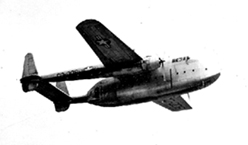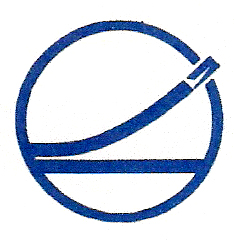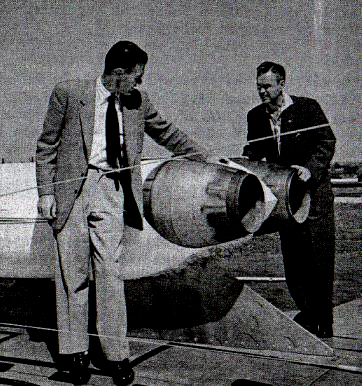
STEWARD-DAVIS JET-PACKET

 |
| A Brief History of Steward-Davis Inc. |
|
Steward-Davis Inc. was founded at Compton Airport, Gardena, California
in 1946 by Herb Steward and Stanley Davis for the purpose of testing and overhauling military surplus radial engines for re-sale into the flourishing post-war airliner market. By 1950 Stan Davis had left the company which retained his name and he was replaced by Dan Thompson whose forte was in promotion and advertising. Herb and Dan then set about expanding the business through aircraft conversions. ---------- They acquired the Type Certificate (No.785), for the Consolidated PBY-5A Catalina and converted over ten aircraft with upgraded Wright Cyclone R-2600 engines, modified tail fin, faired nose and other mods as the Steward-Davis Super Catalina. The "cats" were popular and some overseas companies also performed similar modifications under license. S-D gained Type Certificate AR-12, dated May 13, 1955, for the Northrop F-15A Reporter which they converted for use in Mexico as a photographic aircraft. Three Sikorsky S-51 Dragonfly helicopters were also serviced by S-D in 1955 for re-sale to Mexico. ---------- The Steward-Davis Jet-Packet saga (described in detail below), began in mid 1955 with the acquisition of CAA Type Certificate AR-15. By 1962, Steward-Davis were located at Long Beach Airport and actively marketing their product to US and Latin American operators, unfortunately without many solid sales. Hollywood did however, rent four C-82A aircraft in 1965 for the filming of Elleston Trevor's novel The Flight of the Phoenix. Flying for the film was done with S-D's workhorse - N6887C. ---------- In 1962, Steward-Davis won a big contract to supply the Indian Air Force with up to 27 Jet-Pak 3402 kits plus spares to increase the performance of their C-119G fleet. S-D crews flew to India to complete the modifications. From 1970, Steward-Davis began supplying US C-119G operators with their Jet-Pak 3402 kits, up to 29 were eventually sold. One Jet-Pak C-119G prototype (N383S), was the STOLMASTER which had a choice of 1, 2 or 3 quick-attach jet-pods. First flight was 9 May, 1967. ---------- Hollywood came knocking again in 1968 when Steward-Davis converted ten Vultee BT-13 / BT-15 Valiant trainers into Japanese Aichi D3A Val dive-bombers for the film Tora! Tora! Tora! (1970). They also provided a flyable Catalina (N6108), and five hulks to be later destroyed on set. 100 torpedoes and 400 bombs were also manufactured from fibreglass. ---------- From the 1970's, Steward-Davis concentrated on smaller projects in support of larger aircraft companies. Some of these include the retractable air-stairs and APU technologies for Boeing, jet engine research, servicing the giant Aero-Spacelines Guppy aircraft and providing servicing for aircraft belonging to Hollywood celebrities, one being Ray Charles' Vickers Viscount (N923RC). ---------- Steward-Davis Inc. closed it's doors in 1990, the APU technologies part of the business was brought by Stan Epstein who continued on as Steward-Davis International Inc. in Van Nuys, California. Although carrying the old name it was in fact, a completely new company. It finally closed in 2008. |

The busy Steward-Davis ramp at Long Beach Airport,
California on February 2, 1959.
33 C-82A Packets, 4 C-47 Dakotas, around three PBY-5A Catalinas and a few
other types can be seen, Steward-Davis demilitarised and serviced the C-82
before
they went out to owners and operators in the United States and South America.
This ramp is now occupied by a Boeing plant for building the C-17A Globemaster.
Photo: Ted Whaley Collection.
| The Jet-Packet Saga | ||||||||||||||||
| When the US Navy's McDonnell FH-1 Phantom fighter was declared surplus
and retired in 1953, Herb acquired the Type Certificate, all spares and manufacturing rights to that aircraft's power plant - the Westinghouse J30-W turbojet. Westinghouse itself had left the jet engine business by 1953, leaving S-D to also buy the rights to the J34-WE-34, -36, W-340 and -24C-4D-1 turbojet engines. S-D began selling and overhauling these engines for various military and civil operators worldwide including Australia, France, India, Japan and The Netherlands. They also manufactured from new various engine components as well. ---------- In 1955, the C-82A Packet was retired by the USAF and many began too appear on the civil market as cargo transports, particularly in Latin America. Herb saw the amazing potential his turbojet engines could have in overcoming the Packets greatest weakness - single engine performance. A C-82A losses 78 ft./min. with the loss of an engine while fully loaded, even at full power on the good engine, level flight is unable to be maintained. Steward-Davis applied for and was awarded CAA Type Certificate AR-15 on July 7, 1955 for the C-82 aircraft. The CAA Data Sheets stated that the aircraft could only operate over congested areas up to a weight of 43,560 lbs. which restricted payloads. With congested (populated) areas building up around the flight paths into airports it became fairly important to get an auxiliary jet-powered Packet up and running. The jet-pak design offered operators not only the safety of engine-out performance but also enabled the take-off run to be greatly reduced. With the auxiliary jet running take-off distance was reduced by up to 50% in some cases. ---------- The J30-W engine was installed in a pod (jet-pak) mounted on a pylon which was bolted to the wing center section, mid-fuselage on a C-82A. Plumbing refinements were made to the fuel system which luckily still used the same 100/130 Octane gasoline to power the J30-W, so no additional fuel tanks were required. Although there was provision for added tankage of up to 800 US Gal. (3028 litres) in the outer wings, as an alternative for all internal tankage. The jet-pak oil capacity was 5 US Gal. (19 litres). Controls for the turbojet were also installed in the cockpit with jet-pak start up accomplished via modifications to the hydraulic system connecting a jet-starter unit. It was noted during flight tests that there was some vibrations coming from jet-wash over the horizontal stabilizer. To remedy this, the outer stabilizer tips were removed plus small stream- lined coned-extensions were added onto the ends of the booms below the tails. ---------- Marketing of the C-82A conversions saw them branded as the Jet-Packet 1600, the "1600" coming from the 1,600 lbst. thrust generated by the J30-W. The first flight took place in November, 1956 and operational services began in June, 1958. A single prototype was also converted as the Jet-Packet 3200 which had a twin J30-W jet-pak arrangement, logically the "3200" coming from the combined thrust output of the 1,600 lbst. engines. It first flew in 1957 and went on to become one of the longest serving Packets on the civil market, only one was built however due to the introduction of the J34-WE. The FAA Type Certificate was amended on May 12, 1961 for full weight C-82 operations over congested areas. In August, 1961 Steward-Davis began work on the improved Jet-Packet II, more widely known as the Jet-Packet 3400. The "3400", named after the 3400 lbst. thrust Westinghouse J34-WE turbojet, now occupying the jet-pod position on the dorsal fuselage spine. A conversion was started in March, 1962 and it flew for the first time in October that same year. The FAA Type Certificate was amended 23 July, 1963 for 3400 operations. ---------- In 1962, Steward-Davis had shifted to better facilities at Long Beach Airport, California, at about the same time creating a holding company known as New Frontier Airlift Corp. to look after the anticipated influx of C-82 airframes for jet-pak conversion. New Frontier were headquarted in Phoenix, Arizona with the company president being Henry A. Smith. Some stocks of C-82 aircraft began to accumulate at Long Beach and in a field in Phoenix. S-D had also become the largest owner and supplier of C-82 spare parts in the USA. Many spares were brand-new ex-military and still crated, sales were made to US and Latin American operators. The first Jet-Packet 3400A customer was TWA Airlines which upgraded it's C-82A (N9701F) in 1964. The "A" sub-variant involve modifying some of the aircraft systems, namely the engines, flaps and fuel systems. The landing gear was replaced by lighter Douglas DC-4 sets with the hydraulic system modified to raise and lower them. ---------- J34-WE engines were later developed to incorporate intake duct doors which stopped the engine windmilling during periods of non-operation. This was known as the J3402 Jet-Pak. Like the C-82 conversions themselves, the turbojet auxiliary engine options were also re-named for marketing purposes by Steward-Davis as outlined below: |
||||||||||||||||
|
||||||||||||||||
.jpg) J34-WE-34 |
||||||||||||||||
| Two last Steward-Davis C-82 conversions
were the Skytruck Mk. I
and Skypallet, the latter was a one-off conversion with detachable cargo deck for palletised cargoes. The Skytruck was designed to decrease aircraft empty weight, hence increase payload weight all the while increasing range. The prototype first flew on February 26, 1964 but no FAA Type Certificate amendment would be made. Apart from the aircraft crashing in Mexico that November, killing two S-D pilots, the Jet-Packet market was shrinking away before it had even got off the ground. By 1965, more and more operators were opting for the J34-WE jet-pak version of the Packets more capable descendant, the C-119 Flying Boxcar. Also, there were enough of the more reliable ex-1950's Douglas DC-6, DC-7 and Lockheed Constellation airliners appearing on the civil cargo market as to make buying an older WWII-era C-82 Packet seem like a higher and more expensive risk. By 1970, New Frontier Airlift Corp. was in Bankruptcy, all 30 plus C-82 airframes in Phoenix, AZ. were scrapped with the final handful of Packets at Long Beach scrapped in 1972. Steward-Davis continued on in a customer support role, now supplying J34-WE "Jet-Pak Kits" to C-119 Type Cert. holders and operators, namely Aero Union Corp., Hawkins & Powers Aviation Inc. and Hemet Valley Flying Service. ---------- The C-82 Jet-Packet saga was a bitter-sweet one, Steward-Davis had made an admirable job in creating and marketing what was a well-performing aircraft for companies wanting a STOL-capable, specialist cargo freighter. But there just wasn't enough demand for such an aircraft to make it a viable venture. Time had caught up with them, as it now has with all the piston-engined cargo giants. |
||||||||||||||||
 Steward-Davis employees Charles Hall (left) and Leo Dorney inspect the twin jet-pak arrangement on the prototype Jet-Packet 3200. Photo: Steward-Davis. |
||||||||||||||||
| JET-PACKET VARIANTS | |
.jpg) |
Jet-Packet 1600 The first flight was in November, 1956 and regular service began in June, 1958. The 1600 was the main marketing variant until the 3400 came into service some years later. There were three sub-variants available: Jet-Packet 1600 Standard C-82A with single J30-W jet-pak fitted on the dorsal wing center section. Jet-Packet 1600A As 1600, modifications to engines, fuel, hydraulic, flap, landing gear, brake and emergency systems. Jet-Packet 1600B As 1600A, with P&W R-2800-CB16 engine upgrade. N6887C at Long Beach in 1963. Photo: Eddie Coates. |
.jpg) |
Jet-Packet 3200 A single prototype was developed in 1957 by combining two Westinghouse J30-W engines into a single jet-pak on the fuselage dorsal spine, the total thrust generated was of course 3200 lbst (x2 1600 lbst). Although a success, the design was more or less rendered obsolete by the use of the more powerful J34-WE engine which evolved into the Jet-Packet II series. N5095V at Torrance Municipal Airport circa 1960. Photo: Eddie Coates. |
.jpg) |
Jet-Packet 3400
(Jet-Packet II) Design work began in August, 1961, first flight in October, 1962. This version became the main variant marketed by Steward-Davis. There were three sub-variants available: Jet-Packet 3400 Standard C-82A with single J34-WE jet-pak fitted on the dorsal wing center section. Jet-Packet 3400A As 3400, modifications to engines, fuel, hydraulic, flap, landing gear, brake and emergency systems. Jet-Packet 3400B As 3400A, with P&W R-2800-CB16 engine upgrade. N6985C (but without jet-pak) at Long Beach circa 1962. Photo: John P. Stewart. |
.jpg) |
Skytruck
Mk. I (Jet-Packet III) The Skytruck marketing term applied to a single prototype which was intended to reduce the aircraft's empty weight, increase it's payload weight and increase range with a max payload weight. Design work started on January 1, 1962 with a conversion started on June 1, 1963 and a first flight on February 26, 1964. The aircraft also featured a hot-air de-icing system for the wing and tail leading edges plus alcohol propeller de-icing. Skytruck Mk. II As the Mk. I but with refinements to improve short-field payload. N74127 at Long Beach circa 1964. Photo: Eddie Coates. |
.jpg) |
Skypallet The Skypallet was designed to be the ultimate cargo aircraft. One C-82A (N4828V), was converted in 1963, the basic floor of the fuselage was removed enabling the carriage of large palliated cargoes loaded directly off truck-flatbeds into the aircraft via an internally fitted hoist. With the floor removed, loads of up to 30,000 lbs. could be accommodated. A powered steerable nose-wheel was made so the two-man crew could manoeuvre the aircraft over a load without ever having to leave the cockpit, speeding turn-around times. The Skypallet features could be incorporated into existing C-82 Skytruck aircraft. A first flight was to be in 1965 but theres no evidence it ever flew. N4828V at Long Beach circa 1965. Photo: Andre van Loon Collection. |
| JET-PACKET CONVERSIONS | ||
| Although there were a larger number of
C-82A aircraft on the civil market only nine so far are known to have been converted to Jet-Packet standards. For a full list of Steward-Davis owned Packets see under: US Owners & Registrations. |
||
| Registration | s/n / msn | Remarks |
| Jet-Packet 1600 | ||
| N5102B | 45-57782 / 10152 | Had eventful life mainly in Alaska / later to Jet-Packet 1600A. |
| N6989C | 44-23015 / 10059 | Later to N6887C, Steward-Davis lease aircraft / later to Jet-Packet 1600A. |
| N6990C | 44-23001 / 10045 | Sold overseas to Chile. |
| PP-CEK | 45-57777 / 10147 | Flew with Cruzeiro do Sul, Brazil. |
| Jet-Packet 3200 | ||
| N5095V | 44-23027 / 10071 | Later to N8009E, had eventful life mainly in Alaska. |
| JET-PACKET
II Jet-Packet 3400 |
||
| N4829V | 44-23029 / 10073 | Became a pesticide sprayer / to Jet-Packet 3400A. |
| N6985C | 44-23046 / 10090 | Steward-Davis demonstrator aircraft. |
| N9701F | 45-57814 / 10184 | Had eventful life in Europe with TWA and later in
Alaska. Later to Jet-Packet 3400B. |
| JET-PACKET
III Skytruck Mk. I |
||
| N74127 | 45-57807 / 10177 | Development cut short due to crash in Mexico in 1964. |
| Skypallet | ||
| N4828V | 44-23041 / 10085 | Prototype conversion completed but never flew. |
.jpg)
Steward-Davis' C-82A N74127 was used in 1964 to
make a Ford pick-up truck TV commercial.
Photo: Ted Whaley Collection.
| STEWARD-DAVIS PILOTS & CREW | |
| The following lists all known people who at some point served on or flew
a Steward-Davis Jet-Packet. Some were full time employees and some were free-lance pilots. Please e-mail me via the home-page with additional names or updates. |
|
| Earl Bellotte | Ex-USAF C-82 pilot, flew N6887C, pilot on The Flight of the Phoenix (1965). |
| Lester Coan | Pilot on test flights for N5095V. |
| Don Dinoff | Flew N6887C, co-pilot on Hermosillo Incident. |
| Leo Dorney | S-D Vice President & Chief Pilot. |
| Ian James | Flew N6887C 1964-1965. |
| Cecil Johns | Pilot killed flying N74127 in Mexico, late 1964. |
| Tim Mulligan | Flight Engineer on Hermosillo Incident. |
| Ambrose Pardue | C-82A Pilot. |
| Jim Springer | Co-pilot killed flying N74127 in Mexico, late 1964. |
| Bob Thayer | Flew on N6887C, FAA rep. on The Flight of the Phoenix (1965). |
| Ted Whaley | Flew N6887C, co-pilot on
The Flight of the Phoenix
(1965), pilot on Hermosillo Incident. |
| Hank Whipple | Pilot, involved in C-119 Jet-Pak development for Indian Air Force. |